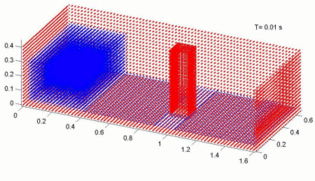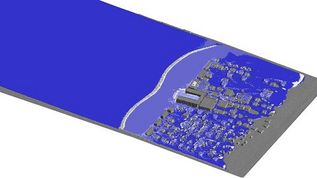ISEC Model Respository
Contributed Models
NOTE: Models in this repository are intended for research and education purposes only. They have been contributed to ISEC by their original developers and are undergoing further development. Thus, any given model may be inaccurate and/or incomplete

|
SPHysics: SPH Free-Surface Flow Solver SPHysics is a Smoothed Particle Hydrodynamics (SPH) code written in fortran for the simulation of potentially violent free-surface hydrodynamics. For release version 1.0, the SPHysics code can simulate various phenomena including wave breaking, dam breaks, sloshing, sliding objects, wave impact on a structure, etc. Recommended for: Researchers familiar with general theory of hydrodynamics Used to: Simulate violent free-surface hydrodynamics, such as wave breaking, wave impact on a structure, dam breaks, and sliding/sloshing objects. |
|||||
|
||||||

|
COULWAVE: Cornell University Long and Intermediate Wave Modeling Package COULWAVE is a free surface wave model. It solves various depth-integrated, long-wave based equation models, including the nonlinear shallow water wave equations and a number of the weakly dispersive Boussinesq-type equations. The primary applications for COULWAVE include landslide tsunami generation and propagation, nearshore tsunami evolution and inundation, and nearshore wind wave modeling. The numerical scheme uses a 4th order finite difference scheme for the spatial derivatives, and a 4th order iterative predictor-corrector scheme for the time integration. Recommended for: Researchers and engineers who are trying to simulate near-shore, wave-driven hydrodynamic processes are the expected users of COULWAVE. The unique features of COULWAVE, as well as other phase-resolving, Boussinesq-type models, are that simulations can be relatively large scale (>10 km2) but contain spatial details on the order 1 m. Used to: COULWAVE has been applied to a wide variety of topics, including rip and long-shore currents, wave run-up, wave-current interaction, and wave generation by underwater landslides, among many others. Directional, random spectrums can readily be generated by the models, which capture near-shore evolution processes, such as shoaling, diffraction, refraction, and wave-wave interactions, with very high accuracy. |
|||||
|
||||||

|
ADCIRC: Advanced Circulation Model ADCIRC is a system of computer programs for solving time dependent, free surface circulation and transport problems in two and three dimensions. These programs utilize the finite element method in space and therefore can be run on highly flexible, irregularly spaced grids. Typical ADCIRC applications have included: (i) modeling tidally and wind driven circulation in coastal waters, (ii) forecasting hurricane storm surge and flooding, (iii) dredging feasibility and material disposal studies, and (iv) larval transport studies. Recommended for: Researchers interested in studying wind and tidal affects on the circulation of coastal waters, storm surge and flooding, larval transport, or dredging feasibilities and material disposal studies. Used to: ADCIRC is an evolving framework used to compute flow and transport in coastal oceans, shelves, estuaries, inlets, floodplains, rivers and beaches. ADCIRC has evolved into a multi-algorithmic code using both the traditional Continuous Galerkin (CG) based algorithms and the new Discontinuous Galerkin (DG) based algorithms. ADCIRC solves 2D shallow water equations (SWE), 3D mass and momentum conservation subject to incompressibility, hydrostatic and Boussinesq approximations, 2D sediment continuity equation, and 2D and 3D temperature and salinity transport equations. |


